Solar eclipse of August 7, 1869
| Solar eclipse of August 7, 1869 | |
|---|---|
 Totality photographed by Morton's party in Iowa | |
| Type of eclipse | |
| Nature | Total |
| Gamma | 0.696 |
| Magnitude | 1.0551 |
| Maximum eclipse | |
| Duration | 228 s (3 min 48 s) |
| Coordinates | 59°06′N 133°12′W / 59.1°N 133.2°W |
| Max. width of band | 254 km (158 mi) |
| Times (UTC) | |
| Greatest eclipse | 22:01:05 |
| References | |
| Saros | 143 (15 of 72) |
| Catalog # (SE5000) | 9209 |
A total solar eclipse occurred at the Moon's ascending node of orbit between Saturday, August 7 and Sunday, August 8, 1869, with a magnitude of 1.0551. A solar eclipse occurs when the Moon passes between Earth and the Sun, thereby totally or partly obscuring the image of the Sun for a viewer on Earth. A total solar eclipse occurs when the Moon's apparent diameter is larger than the Sun's, blocking all direct sunlight, turning day into darkness. Totality occurs in a narrow path across Earth's surface, with the partial solar eclipse visible over a surrounding region thousands of kilometres wide. Occurring about 1.6 days before perigee (on August 9, 1869, at 13:20 UTC), the Moon's apparent diameter was larger.[1]
The path of totality was visible from parts of modern-day eastern Russia, Alaska, western Canada, Montana, North Dakota, South Dakota, Minnesota, Nebraska, Iowa, Missouri, Illinois, Indiana, Kentucky, Tennessee, West Virginia, Virginia, North Carolina, and South Carolina. A partial solar eclipse was also visible for parts of Northeast Asia, North America, Central America, and the Caribbean.
Observations
[edit]
In 1869, astronomer and explorer George Davidson made a scientific trip to the Chilkat Valley of Alaska. He told the Chilkat Indians that he was anxious to observe a total eclipse of the sun that was predicted to occur the following day, August 7. This prediction was considered to have saved Davidson's expedition from an attack.[2]
A photographic expedition was organized by Philadelphia's Henry Morton under the authority of John H. C. Coffin, U.S.N., Superintendent of the American Ephemeris and Nautical Almanac. The expedition observed the eclipse in Iowa at three stations: Burlington, Mount Pleasant, and Ottumwa, under the respective supervisions of Alfred M. Mayer, Henry Morton, and Charles Francis Himes (1838–1918).[3]
Observations were also made by meteorology pioneers Cleveland Abbe and General Albert Myer, in Dakota Territory and Virginia, respectively.[4]
Eclipse details
[edit]Shown below are two tables displaying details about this particular solar eclipse. The first table outlines times at which the moon's penumbra or umbra attains the specific parameter, and the second table describes various other parameters pertaining to this eclipse.[5]
| Event | Time (UTC) |
|---|---|
| First Penumbral External Contact | 1869 August 07 at 19:38:08.9 UTC |
| First Umbral External Contact | 1869 August 07 at 20:44:43.8 UTC |
| First Central Line | 1869 August 07 at 20:46:19.1 UTC |
| First Umbral Internal Contact | 1869 August 07 at 20:47:55.4 UTC |
| Equatorial Conjunction | 1869 August 07 at 21:46:10.8 UTC |
| Greatest Duration | 1869 August 07 at 22:00:53.7 UTC |
| Greatest Eclipse | 1869 August 07 at 22:01:04.7 UTC |
| Ecliptic Conjunction | 1869 August 07 at 22:08:11.2 UTC |
| Last Umbral Internal Contact | 1869 August 07 at 23:14:22.8 UTC |
| Last Central Line | 1869 August 07 at 23:16:00.7 UTC |
| Last Umbral External Contact | 1869 August 07 at 23:17:37.6 UTC |
| Last Penumbral External Contact | 1869 August 08 at 00:24:03.9 UTC |
| Parameter | Value |
|---|---|
| Eclipse Magnitude | 1.05514 |
| Eclipse Obscuration | 1.11332 |
| Gamma | 0.69599 |
| Sun Right Ascension | 09h11m15.8s |
| Sun Declination | +16°14'37.3" |
| Sun Semi-Diameter | 15'46.6" |
| Sun Equatorial Horizontal Parallax | 08.7" |
| Moon Right Ascension | 09h11m50.9s |
| Moon Declination | +16°55'41.0" |
| Moon Semi-Diameter | 16'27.0" |
| Moon Equatorial Horizontal Parallax | 1°00'22.4" |
| ΔT | 1.2 s |
Eclipse season
[edit]This eclipse is part of an eclipse season, a period, roughly every six months, when eclipses occur. Only two (or occasionally three) eclipse seasons occur each year, and each season lasts about 35 days and repeats just short of six months (173 days) later; thus two full eclipse seasons always occur each year. Either two or three eclipses happen each eclipse season. In the sequence below, each eclipse is separated by a fortnight.
| July 23 Descending node (full moon) |
August 7 Ascending node (new moon) |
|---|---|

| |
| Partial lunar eclipse Lunar Saros 117 |
Total solar eclipse Solar Saros 143 |
Related eclipses
[edit]Eclipses in 1869
[edit]- A partial lunar eclipse on January 28.
- An annular solar eclipse on February 11.
- A partial lunar eclipse on July 23.
- A total solar eclipse on August 7.
Metonic
[edit]- Preceded by: Solar eclipse of October 19, 1865
- Followed by: Solar eclipse of May 26, 1873
Tzolkinex
[edit]- Preceded by: Solar eclipse of June 27, 1862
- Followed by: Solar eclipse of September 17, 1876
Half-Saros
[edit]- Preceded by: Lunar eclipse of August 1, 1860
- Followed by: Lunar eclipse of August 13, 1878
Tritos
[edit]- Preceded by: Solar eclipse of September 7, 1858
- Followed by: Solar eclipse of July 7, 1880
Solar Saros 143
[edit]- Preceded by: Solar eclipse of July 28, 1851
- Followed by: Solar eclipse of August 19, 1887
Inex
[edit]- Preceded by: Solar eclipse of August 27, 1840
- Followed by: Solar eclipse of July 18, 1898
Triad
[edit]- Preceded by: Solar eclipse of October 7, 1782
- Followed by: Solar eclipse of June 8, 1956
Solar eclipses of 1866–1870
[edit]This eclipse is a member of a semester series. An eclipse in a semester series of solar eclipses repeats approximately every 177 days and 4 hours (a semester) at alternating nodes of the Moon's orbit.[6]
The partial solar eclipses on April 15, 1866 and October 8, 1866 occur in the previous lunar year eclipse set, and the solar eclipses on June 28, 1870 (partial) and December 22, 1870 (total) occur in the next lunar year eclipse set.
| Solar eclipse series sets from 1866 to 1870 | ||||||
|---|---|---|---|---|---|---|
| Descending node | Ascending node | |||||
| Saros | Map | Gamma | Saros | Map | Gamma | |
| 108 | March 16, 1866 Partial |
1.4241 | 113 | |||
| 118 | March 6, 1867 Annular |
0.7716 | 123 | August 29, 1867 Total |
−0.7940 | |
| 128 | February 23, 1868 Annular |
0.0706 | 133 | August 18, 1868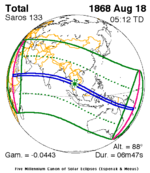 Total |
−0.0443 | |
| 138 | February 11, 1869 Annular |
−0.6251 | 143 | August 7, 1869 Total |
0.6960 | |
| 148 | January 31, 1870 Partial |
−1.2829 | 153 | July 28, 1870 Partial |
1.5044 | |
Saros 143
[edit]This eclipse is a part of Saros series 143, repeating every 18 years, 11 days, and containing 72 events. The series started with a partial solar eclipse on March 7, 1617. It contains total eclipses from June 24, 1797 through October 24, 1995; hybrid eclipses from November 3, 2013 through December 6, 2067; and annular eclipses from December 16, 2085 through September 16, 2536. The series ends at member 72 as a partial eclipse on April 23, 2897. Its eclipses are tabulated in three columns; every third eclipse in the same column is one exeligmos apart, so they all cast shadows over approximately the same parts of the Earth.
The longest duration of totality was produced by member 16 at 3 minutes, 50 seconds on August 19, 1887, and the longest duration of annularity will be produced by member 51 at 4 minutes, 54 seconds on September 6, 2518. All eclipses in this series occur at the Moon’s ascending node of orbit.[7]
| Series members 12–33 occur between 1801 and 2200: | ||
|---|---|---|
| 12 | 13 | 14 |
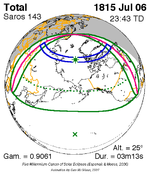 July 6, 1815 |
 July 17, 1833 |
 July 28, 1851 |
| 15 | 16 | 17 |
 August 7, 1869 |
 August 19, 1887 |
 August 30, 1905 |
| 18 | 19 | 20 |
 September 10, 1923 |
 September 21, 1941 |
 October 2, 1959 |
| 21 | 22 | 23 |
 October 12, 1977 |
 October 24, 1995 |
 November 3, 2013 |
| 24 | 25 | 26 |
 November 14, 2031 |
 November 25, 2049 |
 December 6, 2067 |
| 27 | 28 | 29 |
 December 16, 2085 |
 December 29, 2103 |
 January 8, 2122 |
| 30 | 31 | 32 |
 January 20, 2140 |
 January 30, 2158 |
 February 10, 2176 |
| 33 | ||
 February 21, 2194 | ||
Metonic series
[edit]The metonic series repeats eclipses every 19 years (6939.69 days), lasting about 5 cycles. Eclipses occur in nearly the same calendar date. In addition, the octon subseries repeats 1/5 of that or every 3.8 years (1387.94 days). All eclipses in this table occur at the Moon's ascending node.
| 25 eclipse events between March 14, 1801 and August 7, 1888 | ||||
|---|---|---|---|---|
| March 14–15 | December 31–January 1 | October 19–20 | August 7 | May 26–27 |
| 107 | 109 | 111 | 113 | 115 |
 March 14, 1801 |
 January 1, 1805 |
 October 19, 1808 |
 August 7, 1812 |
 May 27, 1816 |
| 117 | 119 | 121 | 123 | 125 |
 March 14, 1820 |
 January 1, 1824 |
 October 20, 1827 |
 August 7, 1831 |
 May 27, 1835 |
| 127 | 129 | 131 | 133 | 135 |
 March 15, 1839 |
 December 31, 1842 |
 October 20, 1846 |
 August 7, 1850 |
 May 26, 1854 |
| 137 | 139 | 141 | 143 | 145 |
 March 15, 1858 |
 December 31, 1861 |
 October 19, 1865 |
 August 7, 1869 |
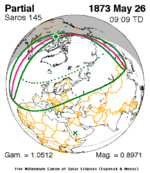 May 26, 1873 |
| 147 | 149 | 151 | 153 | |
 March 15, 1877 |
 December 31, 1880 |
 October 19, 1884 |
 August 7, 1888 | |
Tritos series
[edit]This eclipse is a part of a tritos cycle, repeating at alternating nodes every 135 synodic months (≈ 3986.63 days, or 11 years minus 1 month). Their appearance and longitude are irregular due to a lack of synchronization with the anomalistic month (period of perigee), but groupings of 3 tritos cycles (≈ 33 years minus 3 months) come close (≈ 434.044 anomalistic months), so eclipses are similar in these groupings.
The partial solar eclipse on October 24, 2098 (part of Saros 164) is also a part of this series but is not included in the table below.
| Series members between 1801 and 2011 | ||||
|---|---|---|---|---|
 February 11, 1804 (Saros 137) |
 January 10, 1815 (Saros 138) |
 December 9, 1825 (Saros 139) |
 November 9, 1836 (Saros 140) |
 October 9, 1847 (Saros 141) |
 September 7, 1858 (Saros 142) |
 August 7, 1869 (Saros 143) |
 July 7, 1880 (Saros 144) |
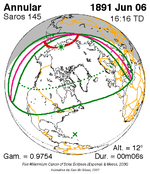 June 6, 1891 (Saros 145) |
 May 7, 1902 (Saros 146) |
 April 6, 1913 (Saros 147) |
 March 5, 1924 (Saros 148) |
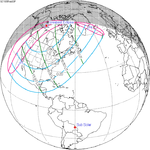 February 3, 1935 (Saros 149) |
 January 3, 1946 (Saros 150) |
 December 2, 1956 (Saros 151) |
 November 2, 1967 (Saros 152) |
 October 2, 1978 (Saros 153) |
 August 31, 1989 (Saros 154) |
 July 31, 2000 (Saros 155) |
 July 1, 2011 (Saros 156) |
Inex series
[edit]This eclipse is a part of the long period inex cycle, repeating at alternating nodes, every 358 synodic months (≈ 10,571.95 days, or 29 years minus 20 days). Their appearance and longitude are irregular due to a lack of synchronization with the anomalistic month (period of perigee). However, groupings of 3 inex cycles (≈ 87 years minus 2 months) comes close (≈ 1,151.02 anomalistic months), so eclipses are similar in these groupings.
| Series members between 1801 and 2200 | ||
|---|---|---|
 September 17, 1811 (Saros 141) |
 August 27, 1840 (Saros 142) |
 August 7, 1869 (Saros 143) |
 July 18, 1898 (Saros 144) |
 June 29, 1927 (Saros 145) |
 June 8, 1956 (Saros 146) |
 May 19, 1985 (Saros 147) |
 April 29, 2014 (Saros 148) |
 April 9, 2043 (Saros 149) |
 March 19, 2072 (Saros 150) |
 February 28, 2101 (Saros 151) |
 February 8, 2130 (Saros 152) |
 January 19, 2159 (Saros 153) |
 December 29, 2187 (Saros 154) |
|
Notes
[edit]- ^ "Moon Distances for London, United Kingdom, England". timeanddate. Retrieved 3 September 2024.
- ^ August 7, 1869, Astronomer impresses Indians with eclipse George Davidson, a prominent astronomer and explorer, impresses Alaskan Native Americans with his ability to predict a total solar eclipse.
- ^ Mayer, Alfred (1869). "An Abstract of Some of the Results of Measurements and Examinations of the Photographs of the Total Solar Eclipse of August 7, 1869". Proceedings of the American Philosophical Society. 11 (81): 204–208.
- ^ David Baron, American Eclipse, p. 158
- ^ "Total Solar Eclipse of 1869 Aug 07". EclipseWise.com. Retrieved 3 September 2024.
- ^ van Gent, R.H. "Solar- and Lunar-Eclipse Predictions from Antiquity to the Present". A Catalogue of Eclipse Cycles. Utrecht University. Retrieved 6 October 2018.
- ^ "NASA - Catalog of Solar Eclipses of Saros 143". eclipse.gsfc.nasa.gov.
References
[edit]- NASA graphics
- Sketch of Solar Corona 1869 August 7
- The Solar Eclipse of 7 August 1869 P 70: Coast Survey Report 1869, 126–127, Cambridge, August 20, 1869
- Observatory, United States Naval (1870). Reports on observations of the total eclipse of the sun, August 7, 1869 (Google eBook).




